Commercial Law: Contract of Service and Contract for Service Analysis
VerifiedAdded on 2021/06/17
|11
|2542
|49
Report
AI Summary
This report provides a comprehensive analysis of the distinctions between a contract of service (employment contract) and a contract for service (independent contractor agreement) within the realm of commercial law. It explores the legal definitions, emphasizing the control an employer has over an employee's work in a contract of service, in contrast to the contractor's autonomy in a contract for service. The report highlights the importance of differentiating these contract types, particularly regarding employee rights and protections as outlined in the Employment Rights Act 1996 and Employment Protection Act 1978. It covers vicarious liability, unfair dismissal, employer and employee duties, taxation, and intellectual property rights, supported by case law such as Cassidy v Ministry of Health and Massey v Crown Life Insurance Co. The report concludes by discussing tests used to determine the nature of the contract, such as the integration, control, and mutual obligations tests, emphasizing the need for clear guidelines to protect both employers and employees.
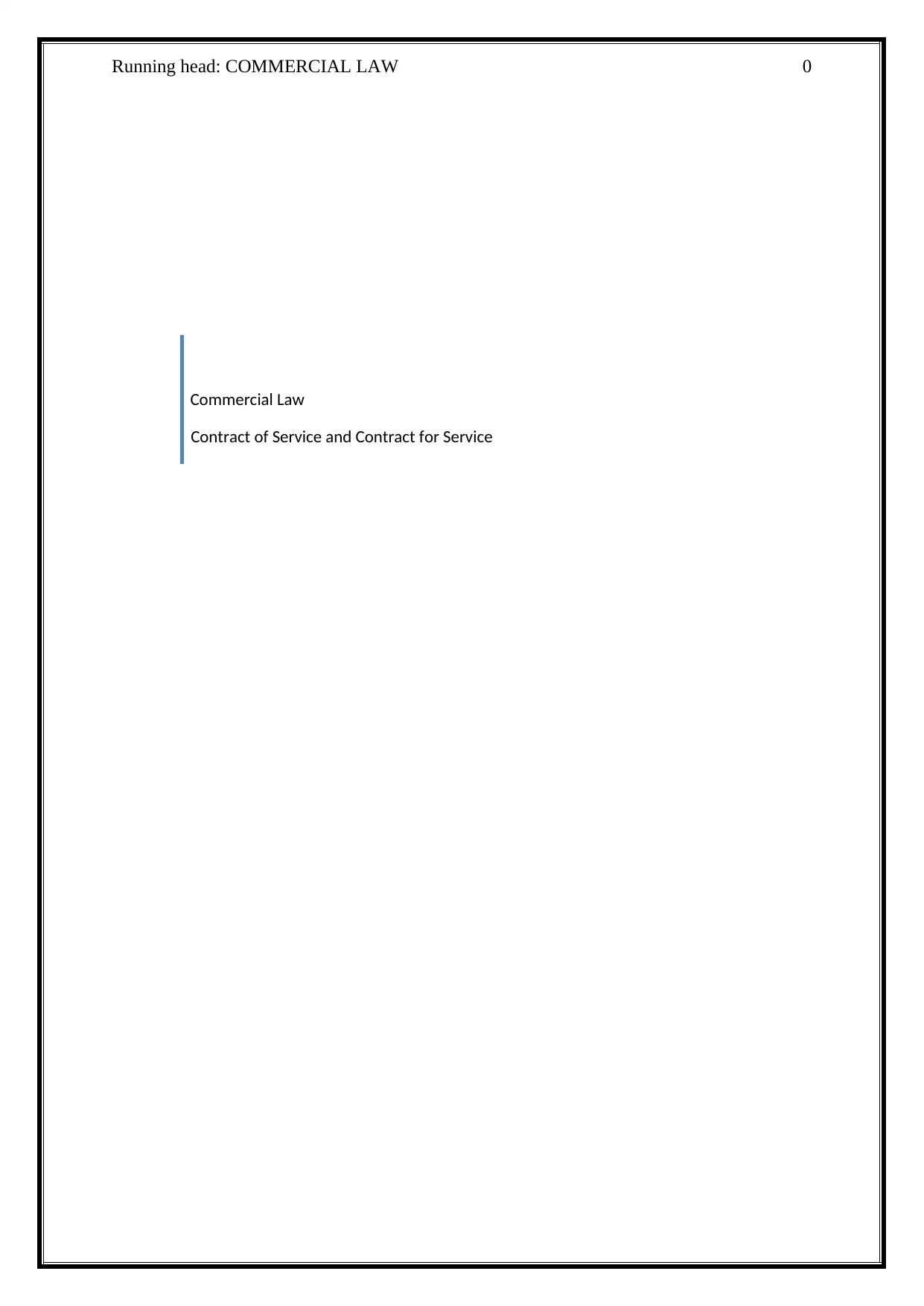
Running head: COMMERCIAL LAW 0
Commercial Law
Contract of Service and Contract for Service
Commercial Law
Contract of Service and Contract for Service
Paraphrase This Document
Need a fresh take? Get an instant paraphrase of this document with our AI Paraphraser
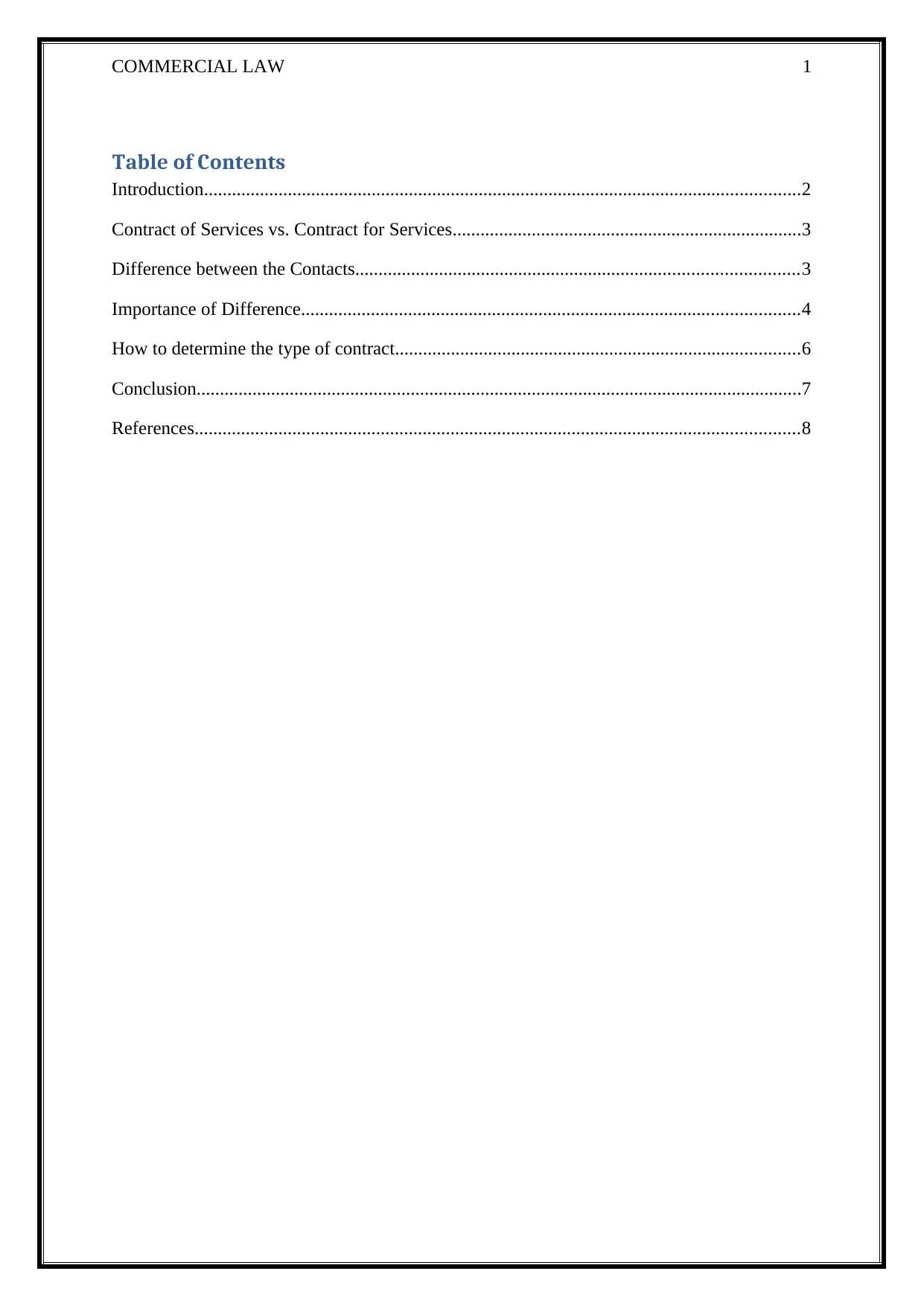
COMMERCIAL LAW 1
Table of Contents
Introduction................................................................................................................................2
Contract of Services vs. Contract for Services...........................................................................3
Difference between the Contacts...............................................................................................3
Importance of Difference...........................................................................................................4
How to determine the type of contract.......................................................................................6
Conclusion..................................................................................................................................7
References..................................................................................................................................8
Table of Contents
Introduction................................................................................................................................2
Contract of Services vs. Contract for Services...........................................................................3
Difference between the Contacts...............................................................................................3
Importance of Difference...........................................................................................................4
How to determine the type of contract.......................................................................................6
Conclusion..................................................................................................................................7
References..................................................................................................................................8

COMMERCIAL LAW 2
Introduction
A contract is a legal agreement which binds two or more parties to its terms. The parties can
enforce each other legally to perform the terms of the contract. In today’s fast pacing business
worlds, the impact of economic crises has increased issues for enterprises, and they face a
number of risks relating with a change in virtual technologies and increasing demand for
skilled workers. Organisations rely on legal contracts In order to keep up with the ever-
changing technologies and retaining skilled employees in the workplace. An effective
understanding of the different types of contracts between contractors, clients, agencies and
employees is crucial for a business. Whenever a party gives his/her consent to do any work
for another party in return for specific remuneration the potential of two different types of
contracts arises based on the specific terms and conditions based on which the work will be
performed (McKendrick, 2014). The two different types of contracts include contract of
services or contract for services. This report will analyse the difference between contract of
service and contract for service and evaluate why it is important for organisations to
differentiate between them.
Introduction
A contract is a legal agreement which binds two or more parties to its terms. The parties can
enforce each other legally to perform the terms of the contract. In today’s fast pacing business
worlds, the impact of economic crises has increased issues for enterprises, and they face a
number of risks relating with a change in virtual technologies and increasing demand for
skilled workers. Organisations rely on legal contracts In order to keep up with the ever-
changing technologies and retaining skilled employees in the workplace. An effective
understanding of the different types of contracts between contractors, clients, agencies and
employees is crucial for a business. Whenever a party gives his/her consent to do any work
for another party in return for specific remuneration the potential of two different types of
contracts arises based on the specific terms and conditions based on which the work will be
performed (McKendrick, 2014). The two different types of contracts include contract of
services or contract for services. This report will analyse the difference between contract of
service and contract for service and evaluate why it is important for organisations to
differentiate between them.
⊘ This is a preview!⊘
Do you want full access?
Subscribe today to unlock all pages.

Trusted by 1+ million students worldwide
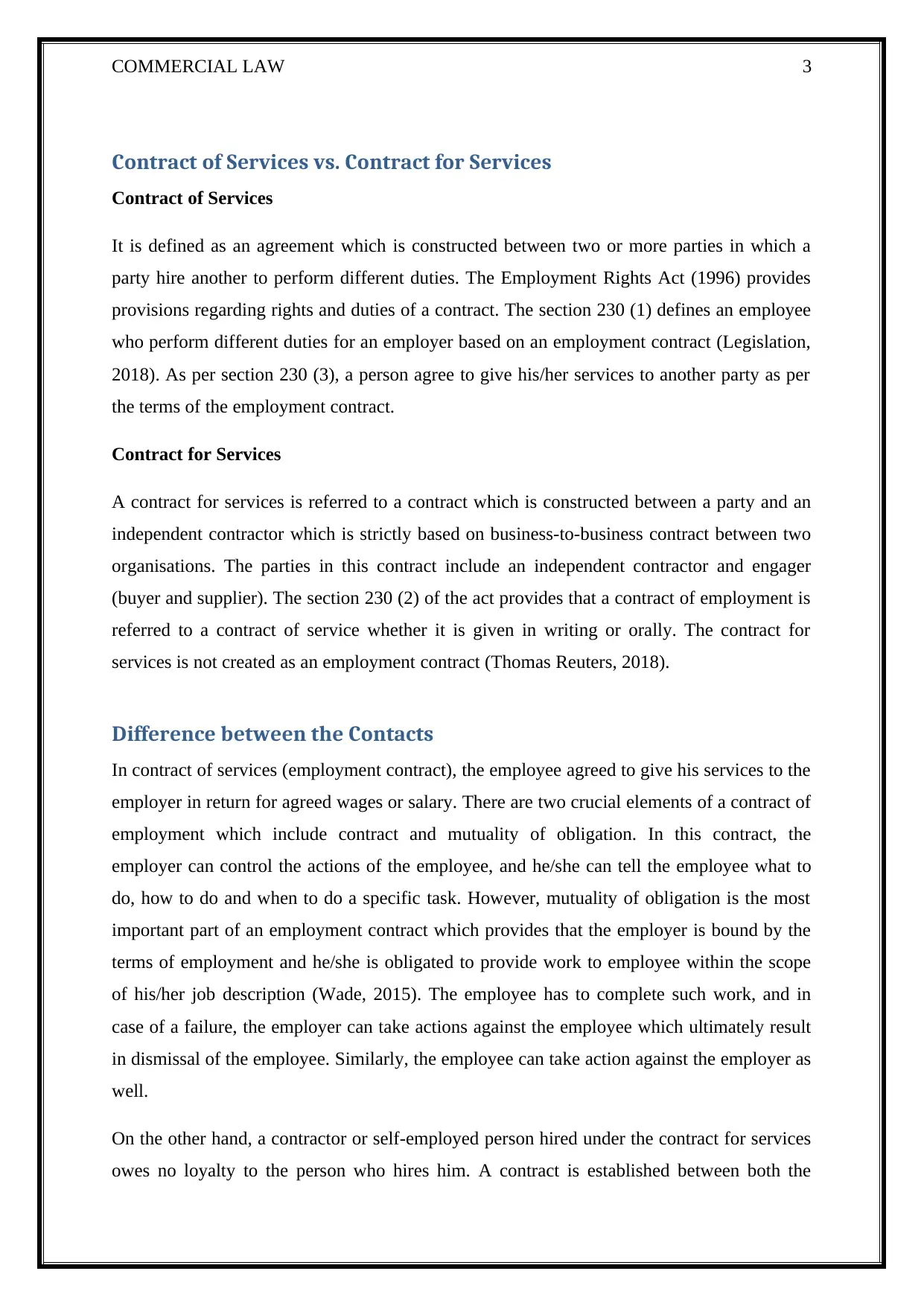
COMMERCIAL LAW 3
Contract of Services vs. Contract for Services
Contract of Services
It is defined as an agreement which is constructed between two or more parties in which a
party hire another to perform different duties. The Employment Rights Act (1996) provides
provisions regarding rights and duties of a contract. The section 230 (1) defines an employee
who perform different duties for an employer based on an employment contract (Legislation,
2018). As per section 230 (3), a person agree to give his/her services to another party as per
the terms of the employment contract.
Contract for Services
A contract for services is referred to a contract which is constructed between a party and an
independent contractor which is strictly based on business-to-business contract between two
organisations. The parties in this contract include an independent contractor and engager
(buyer and supplier). The section 230 (2) of the act provides that a contract of employment is
referred to a contract of service whether it is given in writing or orally. The contract for
services is not created as an employment contract (Thomas Reuters, 2018).
Difference between the Contacts
In contract of services (employment contract), the employee agreed to give his services to the
employer in return for agreed wages or salary. There are two crucial elements of a contract of
employment which include contract and mutuality of obligation. In this contract, the
employer can control the actions of the employee, and he/she can tell the employee what to
do, how to do and when to do a specific task. However, mutuality of obligation is the most
important part of an employment contract which provides that the employer is bound by the
terms of employment and he/she is obligated to provide work to employee within the scope
of his/her job description (Wade, 2015). The employee has to complete such work, and in
case of a failure, the employer can take actions against the employee which ultimately result
in dismissal of the employee. Similarly, the employee can take action against the employer as
well.
On the other hand, a contractor or self-employed person hired under the contract for services
owes no loyalty to the person who hires him. A contract is established between both the
Contract of Services vs. Contract for Services
Contract of Services
It is defined as an agreement which is constructed between two or more parties in which a
party hire another to perform different duties. The Employment Rights Act (1996) provides
provisions regarding rights and duties of a contract. The section 230 (1) defines an employee
who perform different duties for an employer based on an employment contract (Legislation,
2018). As per section 230 (3), a person agree to give his/her services to another party as per
the terms of the employment contract.
Contract for Services
A contract for services is referred to a contract which is constructed between a party and an
independent contractor which is strictly based on business-to-business contract between two
organisations. The parties in this contract include an independent contractor and engager
(buyer and supplier). The section 230 (2) of the act provides that a contract of employment is
referred to a contract of service whether it is given in writing or orally. The contract for
services is not created as an employment contract (Thomas Reuters, 2018).
Difference between the Contacts
In contract of services (employment contract), the employee agreed to give his services to the
employer in return for agreed wages or salary. There are two crucial elements of a contract of
employment which include contract and mutuality of obligation. In this contract, the
employer can control the actions of the employee, and he/she can tell the employee what to
do, how to do and when to do a specific task. However, mutuality of obligation is the most
important part of an employment contract which provides that the employer is bound by the
terms of employment and he/she is obligated to provide work to employee within the scope
of his/her job description (Wade, 2015). The employee has to complete such work, and in
case of a failure, the employer can take actions against the employee which ultimately result
in dismissal of the employee. Similarly, the employee can take action against the employer as
well.
On the other hand, a contractor or self-employed person hired under the contract for services
owes no loyalty to the person who hires him. A contract is established between both the
Paraphrase This Document
Need a fresh take? Get an instant paraphrase of this document with our AI Paraphraser
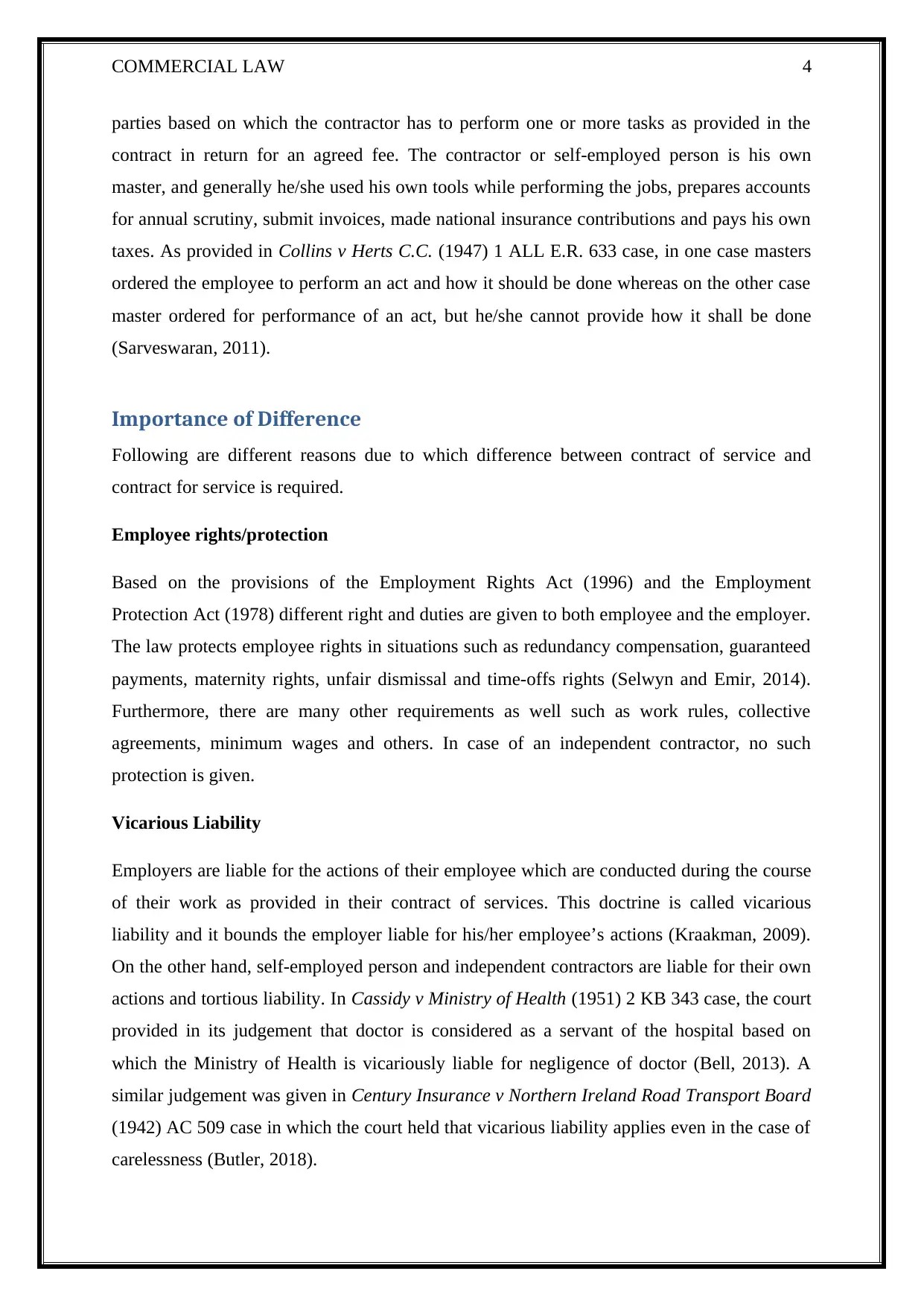
COMMERCIAL LAW 4
parties based on which the contractor has to perform one or more tasks as provided in the
contract in return for an agreed fee. The contractor or self-employed person is his own
master, and generally he/she used his own tools while performing the jobs, prepares accounts
for annual scrutiny, submit invoices, made national insurance contributions and pays his own
taxes. As provided in Collins v Herts C.C. (1947) 1 ALL E.R. 633 case, in one case masters
ordered the employee to perform an act and how it should be done whereas on the other case
master ordered for performance of an act, but he/she cannot provide how it shall be done
(Sarveswaran, 2011).
Importance of Difference
Following are different reasons due to which difference between contract of service and
contract for service is required.
Employee rights/protection
Based on the provisions of the Employment Rights Act (1996) and the Employment
Protection Act (1978) different right and duties are given to both employee and the employer.
The law protects employee rights in situations such as redundancy compensation, guaranteed
payments, maternity rights, unfair dismissal and time-offs rights (Selwyn and Emir, 2014).
Furthermore, there are many other requirements as well such as work rules, collective
agreements, minimum wages and others. In case of an independent contractor, no such
protection is given.
Vicarious Liability
Employers are liable for the actions of their employee which are conducted during the course
of their work as provided in their contract of services. This doctrine is called vicarious
liability and it bounds the employer liable for his/her employee’s actions (Kraakman, 2009).
On the other hand, self-employed person and independent contractors are liable for their own
actions and tortious liability. In Cassidy v Ministry of Health (1951) 2 KB 343 case, the court
provided in its judgement that doctor is considered as a servant of the hospital based on
which the Ministry of Health is vicariously liable for negligence of doctor (Bell, 2013). A
similar judgement was given in Century Insurance v Northern Ireland Road Transport Board
(1942) AC 509 case in which the court held that vicarious liability applies even in the case of
carelessness (Butler, 2018).
parties based on which the contractor has to perform one or more tasks as provided in the
contract in return for an agreed fee. The contractor or self-employed person is his own
master, and generally he/she used his own tools while performing the jobs, prepares accounts
for annual scrutiny, submit invoices, made national insurance contributions and pays his own
taxes. As provided in Collins v Herts C.C. (1947) 1 ALL E.R. 633 case, in one case masters
ordered the employee to perform an act and how it should be done whereas on the other case
master ordered for performance of an act, but he/she cannot provide how it shall be done
(Sarveswaran, 2011).
Importance of Difference
Following are different reasons due to which difference between contract of service and
contract for service is required.
Employee rights/protection
Based on the provisions of the Employment Rights Act (1996) and the Employment
Protection Act (1978) different right and duties are given to both employee and the employer.
The law protects employee rights in situations such as redundancy compensation, guaranteed
payments, maternity rights, unfair dismissal and time-offs rights (Selwyn and Emir, 2014).
Furthermore, there are many other requirements as well such as work rules, collective
agreements, minimum wages and others. In case of an independent contractor, no such
protection is given.
Vicarious Liability
Employers are liable for the actions of their employee which are conducted during the course
of their work as provided in their contract of services. This doctrine is called vicarious
liability and it bounds the employer liable for his/her employee’s actions (Kraakman, 2009).
On the other hand, self-employed person and independent contractors are liable for their own
actions and tortious liability. In Cassidy v Ministry of Health (1951) 2 KB 343 case, the court
provided in its judgement that doctor is considered as a servant of the hospital based on
which the Ministry of Health is vicariously liable for negligence of doctor (Bell, 2013). A
similar judgement was given in Century Insurance v Northern Ireland Road Transport Board
(1942) AC 509 case in which the court held that vicarious liability applies even in the case of
carelessness (Butler, 2018).

COMMERCIAL LAW 5
Unfair Dismissal
Employees are protected under the rights of the Unfair Dismissals Act whereas it did not
apply to self-employed or independent contractors. The case law of Massey v Crown Life
Insurance Co (CLI) (1978) IRLR 31 is a good example. In this case, the claimant was
employed in the post of manager by CLI, but later terms of his agreement were changed, and
he became self-employed (Nyombi, 2015). When the company ended his employment, he
claimed for unfair dismissal however the court held that he did not have the protection
because he was self-employed. It is necessary that the employee prove his employment
relation in case of an unfair dismissal claim.
Duties of the Employer
The employer has the duty to pay the employee for the period of his/her employment. A good
example was given in Devonald v Rosser & Sons (1906) 2 KB 728 case, in which the
employer closed his business, and two weeks later he terminated the contract of its employees
(Freedland et al., 2016). The employees filed for the payment of two weeks’ salary; the court
held that the employer is liable to pay employees salary for two weeks. Moreover, an
employer is obligated to provide work to his/her employees. However, if an employee is paid,
then the employer is not obligated to provide him work. In Langston v AUEW (1974) ICR
180 case, the employer fired the employee without giving him his basic wage and overtime
payments. The court provided that the employer is not liable to provide work, but he is
obligated to make the payments.
Duties of an Employee
The employee has to perform a number of duties for his/her employer as per the employment
contract. He/she has to obey different instructions which are reasonable and legal. As
provided in the case of Morrish v Henlys Ltd (1973), the employer asks an employee to
falsify the accounts which were an illegal act. It is necessary that an employee cooperate with
the employer, and the employee should not take any action that might conflict the duties
which he/she required to perform for the employer (Marson, 2014). In Sanders v Parry
(1967) 1 WLR 753 case, it was held that the employee must not compete with the employer.
Taxation
Unfair Dismissal
Employees are protected under the rights of the Unfair Dismissals Act whereas it did not
apply to self-employed or independent contractors. The case law of Massey v Crown Life
Insurance Co (CLI) (1978) IRLR 31 is a good example. In this case, the claimant was
employed in the post of manager by CLI, but later terms of his agreement were changed, and
he became self-employed (Nyombi, 2015). When the company ended his employment, he
claimed for unfair dismissal however the court held that he did not have the protection
because he was self-employed. It is necessary that the employee prove his employment
relation in case of an unfair dismissal claim.
Duties of the Employer
The employer has the duty to pay the employee for the period of his/her employment. A good
example was given in Devonald v Rosser & Sons (1906) 2 KB 728 case, in which the
employer closed his business, and two weeks later he terminated the contract of its employees
(Freedland et al., 2016). The employees filed for the payment of two weeks’ salary; the court
held that the employer is liable to pay employees salary for two weeks. Moreover, an
employer is obligated to provide work to his/her employees. However, if an employee is paid,
then the employer is not obligated to provide him work. In Langston v AUEW (1974) ICR
180 case, the employer fired the employee without giving him his basic wage and overtime
payments. The court provided that the employer is not liable to provide work, but he is
obligated to make the payments.
Duties of an Employee
The employee has to perform a number of duties for his/her employer as per the employment
contract. He/she has to obey different instructions which are reasonable and legal. As
provided in the case of Morrish v Henlys Ltd (1973), the employer asks an employee to
falsify the accounts which were an illegal act. It is necessary that an employee cooperate with
the employer, and the employee should not take any action that might conflict the duties
which he/she required to perform for the employer (Marson, 2014). In Sanders v Parry
(1967) 1 WLR 753 case, it was held that the employee must not compete with the employer.
Taxation
⊘ This is a preview!⊘
Do you want full access?
Subscribe today to unlock all pages.

Trusted by 1+ million students worldwide
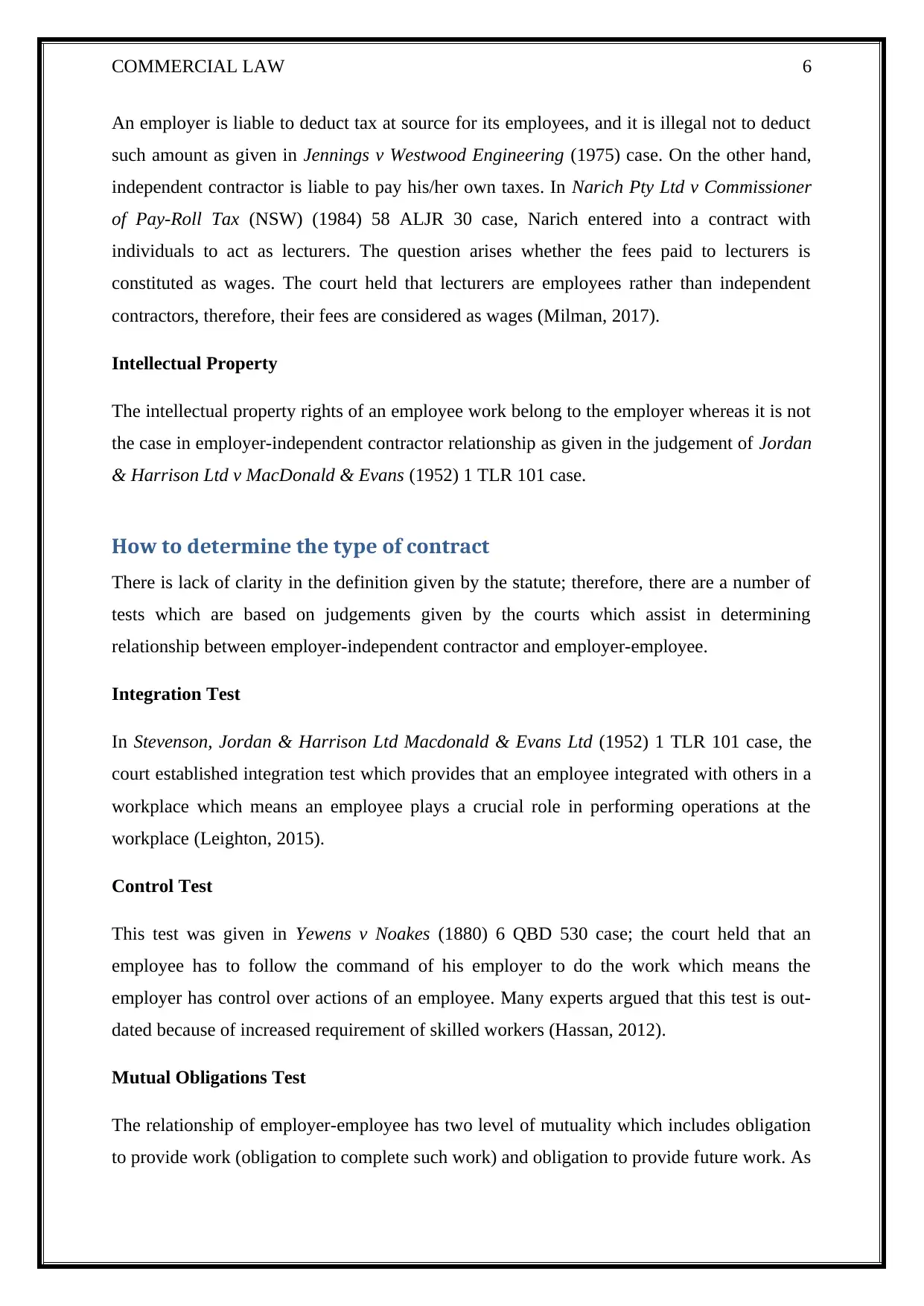
COMMERCIAL LAW 6
An employer is liable to deduct tax at source for its employees, and it is illegal not to deduct
such amount as given in Jennings v Westwood Engineering (1975) case. On the other hand,
independent contractor is liable to pay his/her own taxes. In Narich Pty Ltd v Commissioner
of Pay-Roll Tax (NSW) (1984) 58 ALJR 30 case, Narich entered into a contract with
individuals to act as lecturers. The question arises whether the fees paid to lecturers is
constituted as wages. The court held that lecturers are employees rather than independent
contractors, therefore, their fees are considered as wages (Milman, 2017).
Intellectual Property
The intellectual property rights of an employee work belong to the employer whereas it is not
the case in employer-independent contractor relationship as given in the judgement of Jordan
& Harrison Ltd v MacDonald & Evans (1952) 1 TLR 101 case.
How to determine the type of contract
There is lack of clarity in the definition given by the statute; therefore, there are a number of
tests which are based on judgements given by the courts which assist in determining
relationship between employer-independent contractor and employer-employee.
Integration Test
In Stevenson, Jordan & Harrison Ltd Macdonald & Evans Ltd (1952) 1 TLR 101 case, the
court established integration test which provides that an employee integrated with others in a
workplace which means an employee plays a crucial role in performing operations at the
workplace (Leighton, 2015).
Control Test
This test was given in Yewens v Noakes (1880) 6 QBD 530 case; the court held that an
employee has to follow the command of his employer to do the work which means the
employer has control over actions of an employee. Many experts argued that this test is out-
dated because of increased requirement of skilled workers (Hassan, 2012).
Mutual Obligations Test
The relationship of employer-employee has two level of mutuality which includes obligation
to provide work (obligation to complete such work) and obligation to provide future work. As
An employer is liable to deduct tax at source for its employees, and it is illegal not to deduct
such amount as given in Jennings v Westwood Engineering (1975) case. On the other hand,
independent contractor is liable to pay his/her own taxes. In Narich Pty Ltd v Commissioner
of Pay-Roll Tax (NSW) (1984) 58 ALJR 30 case, Narich entered into a contract with
individuals to act as lecturers. The question arises whether the fees paid to lecturers is
constituted as wages. The court held that lecturers are employees rather than independent
contractors, therefore, their fees are considered as wages (Milman, 2017).
Intellectual Property
The intellectual property rights of an employee work belong to the employer whereas it is not
the case in employer-independent contractor relationship as given in the judgement of Jordan
& Harrison Ltd v MacDonald & Evans (1952) 1 TLR 101 case.
How to determine the type of contract
There is lack of clarity in the definition given by the statute; therefore, there are a number of
tests which are based on judgements given by the courts which assist in determining
relationship between employer-independent contractor and employer-employee.
Integration Test
In Stevenson, Jordan & Harrison Ltd Macdonald & Evans Ltd (1952) 1 TLR 101 case, the
court established integration test which provides that an employee integrated with others in a
workplace which means an employee plays a crucial role in performing operations at the
workplace (Leighton, 2015).
Control Test
This test was given in Yewens v Noakes (1880) 6 QBD 530 case; the court held that an
employee has to follow the command of his employer to do the work which means the
employer has control over actions of an employee. Many experts argued that this test is out-
dated because of increased requirement of skilled workers (Hassan, 2012).
Mutual Obligations Test
The relationship of employer-employee has two level of mutuality which includes obligation
to provide work (obligation to complete such work) and obligation to provide future work. As
Paraphrase This Document
Need a fresh take? Get an instant paraphrase of this document with our AI Paraphraser
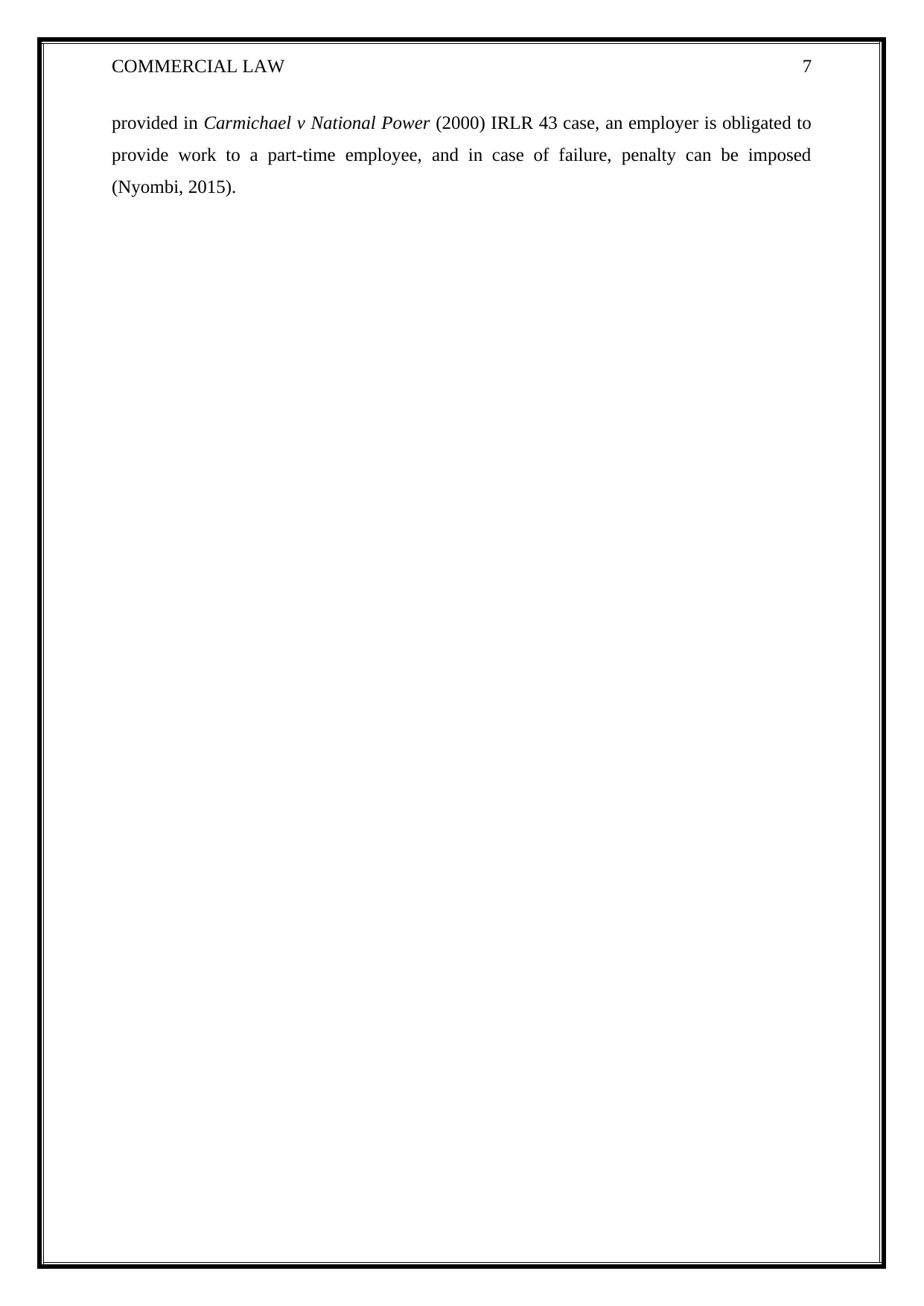
COMMERCIAL LAW 7
provided in Carmichael v National Power (2000) IRLR 43 case, an employer is obligated to
provide work to a part-time employee, and in case of failure, penalty can be imposed
(Nyombi, 2015).
provided in Carmichael v National Power (2000) IRLR 43 case, an employer is obligated to
provide work to a part-time employee, and in case of failure, penalty can be imposed
(Nyombi, 2015).

COMMERCIAL LAW 8
Conclusion
In conclusion, modern companies prefer to hire self-employed people instead of offering
them a contract of employment to avoid duties which resulted in increasing freelancing jobs.
Many organisations disguise it as outsourcing however in outsourcing the company has to use
workers as an employee and comply with different duties relating to them which make it
different. A corporation is required to protect its resources and maintain its competitive
advantage; on the other hand, they are required to focus on protecting employees from
exploitation. In order to differentiate the contract of services from the contract for services,
clear guidelines are not given in the Employment Right Act (1996), and enterprises have to
rely on the judgement of the courts. Therefore, new guidelines and tests should be included in
the law which assists enterprises in differentiating between the two contracts because it
assists them in protecting their resources and employees rights from exploitation. Therefore,
it is important to differentiate between a contract of services and a contract for services.
Conclusion
In conclusion, modern companies prefer to hire self-employed people instead of offering
them a contract of employment to avoid duties which resulted in increasing freelancing jobs.
Many organisations disguise it as outsourcing however in outsourcing the company has to use
workers as an employee and comply with different duties relating to them which make it
different. A corporation is required to protect its resources and maintain its competitive
advantage; on the other hand, they are required to focus on protecting employees from
exploitation. In order to differentiate the contract of services from the contract for services,
clear guidelines are not given in the Employment Right Act (1996), and enterprises have to
rely on the judgement of the courts. Therefore, new guidelines and tests should be included in
the law which assists enterprises in differentiating between the two contracts because it
assists them in protecting their resources and employees rights from exploitation. Therefore,
it is important to differentiate between a contract of services and a contract for services.
⊘ This is a preview!⊘
Do you want full access?
Subscribe today to unlock all pages.

Trusted by 1+ million students worldwide
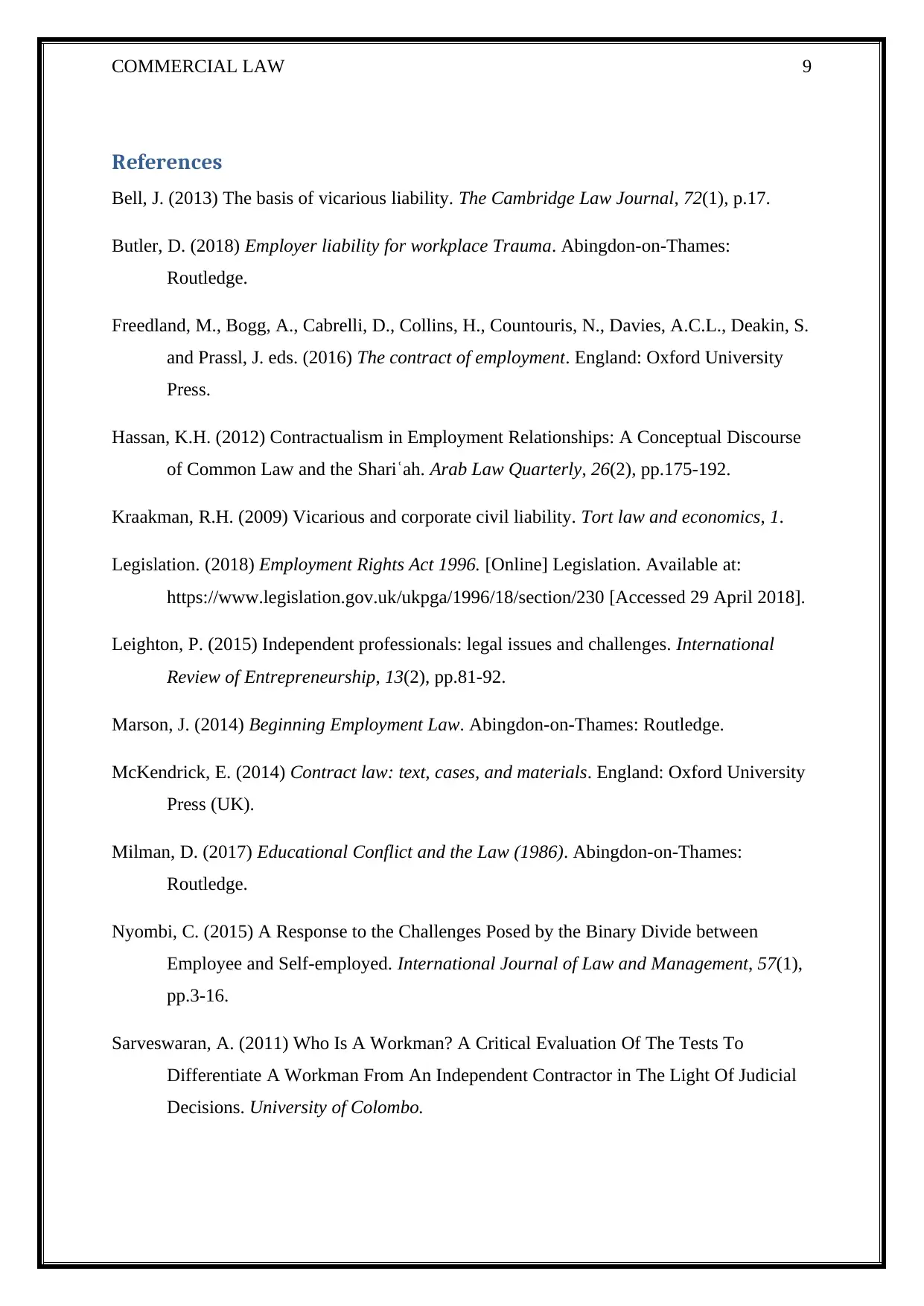
COMMERCIAL LAW 9
References
Bell, J. (2013) The basis of vicarious liability. The Cambridge Law Journal, 72(1), p.17.
Butler, D. (2018) Employer liability for workplace Trauma. Abingdon-on-Thames:
Routledge.
Freedland, M., Bogg, A., Cabrelli, D., Collins, H., Countouris, N., Davies, A.C.L., Deakin, S.
and Prassl, J. eds. (2016) The contract of employment. England: Oxford University
Press.
Hassan, K.H. (2012) Contractualism in Employment Relationships: A Conceptual Discourse
of Common Law and the Shariʿah. Arab Law Quarterly, 26(2), pp.175-192.
Kraakman, R.H. (2009) Vicarious and corporate civil liability. Tort law and economics, 1.
Legislation. (2018) Employment Rights Act 1996. [Online] Legislation. Available at:
https://www.legislation.gov.uk/ukpga/1996/18/section/230 [Accessed 29 April 2018].
Leighton, P. (2015) Independent professionals: legal issues and challenges. International
Review of Entrepreneurship, 13(2), pp.81-92.
Marson, J. (2014) Beginning Employment Law. Abingdon-on-Thames: Routledge.
McKendrick, E. (2014) Contract law: text, cases, and materials. England: Oxford University
Press (UK).
Milman, D. (2017) Educational Conflict and the Law (1986). Abingdon-on-Thames:
Routledge.
Nyombi, C. (2015) A Response to the Challenges Posed by the Binary Divide between
Employee and Self-employed. International Journal of Law and Management, 57(1),
pp.3-16.
Sarveswaran, A. (2011) Who Is A Workman? A Critical Evaluation Of The Tests To
Differentiate A Workman From An Independent Contractor in The Light Of Judicial
Decisions. University of Colombo.
References
Bell, J. (2013) The basis of vicarious liability. The Cambridge Law Journal, 72(1), p.17.
Butler, D. (2018) Employer liability for workplace Trauma. Abingdon-on-Thames:
Routledge.
Freedland, M., Bogg, A., Cabrelli, D., Collins, H., Countouris, N., Davies, A.C.L., Deakin, S.
and Prassl, J. eds. (2016) The contract of employment. England: Oxford University
Press.
Hassan, K.H. (2012) Contractualism in Employment Relationships: A Conceptual Discourse
of Common Law and the Shariʿah. Arab Law Quarterly, 26(2), pp.175-192.
Kraakman, R.H. (2009) Vicarious and corporate civil liability. Tort law and economics, 1.
Legislation. (2018) Employment Rights Act 1996. [Online] Legislation. Available at:
https://www.legislation.gov.uk/ukpga/1996/18/section/230 [Accessed 29 April 2018].
Leighton, P. (2015) Independent professionals: legal issues and challenges. International
Review of Entrepreneurship, 13(2), pp.81-92.
Marson, J. (2014) Beginning Employment Law. Abingdon-on-Thames: Routledge.
McKendrick, E. (2014) Contract law: text, cases, and materials. England: Oxford University
Press (UK).
Milman, D. (2017) Educational Conflict and the Law (1986). Abingdon-on-Thames:
Routledge.
Nyombi, C. (2015) A Response to the Challenges Posed by the Binary Divide between
Employee and Self-employed. International Journal of Law and Management, 57(1),
pp.3-16.
Sarveswaran, A. (2011) Who Is A Workman? A Critical Evaluation Of The Tests To
Differentiate A Workman From An Independent Contractor in The Light Of Judicial
Decisions. University of Colombo.
Paraphrase This Document
Need a fresh take? Get an instant paraphrase of this document with our AI Paraphraser
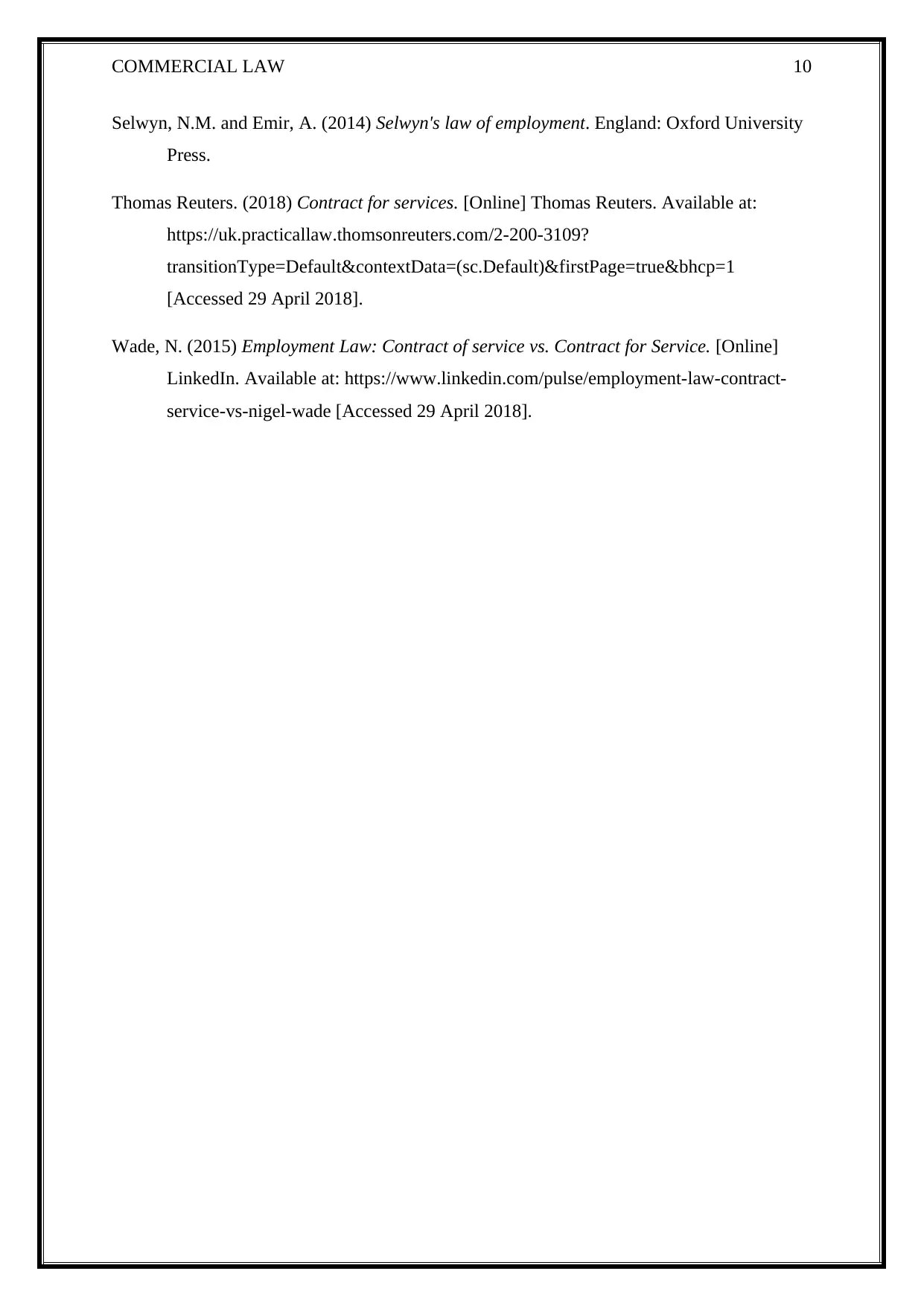
COMMERCIAL LAW 10
Selwyn, N.M. and Emir, A. (2014) Selwyn's law of employment. England: Oxford University
Press.
Thomas Reuters. (2018) Contract for services. [Online] Thomas Reuters. Available at:
https://uk.practicallaw.thomsonreuters.com/2-200-3109?
transitionType=Default&contextData=(sc.Default)&firstPage=true&bhcp=1
[Accessed 29 April 2018].
Wade, N. (2015) Employment Law: Contract of service vs. Contract for Service. [Online]
LinkedIn. Available at: https://www.linkedin.com/pulse/employment-law-contract-
service-vs-nigel-wade [Accessed 29 April 2018].
Selwyn, N.M. and Emir, A. (2014) Selwyn's law of employment. England: Oxford University
Press.
Thomas Reuters. (2018) Contract for services. [Online] Thomas Reuters. Available at:
https://uk.practicallaw.thomsonreuters.com/2-200-3109?
transitionType=Default&contextData=(sc.Default)&firstPage=true&bhcp=1
[Accessed 29 April 2018].
Wade, N. (2015) Employment Law: Contract of service vs. Contract for Service. [Online]
LinkedIn. Available at: https://www.linkedin.com/pulse/employment-law-contract-
service-vs-nigel-wade [Accessed 29 April 2018].
1 out of 11
Related Documents
Your All-in-One AI-Powered Toolkit for Academic Success.
+13062052269
info@desklib.com
Available 24*7 on WhatsApp / Email
![[object Object]](/_next/static/media/star-bottom.7253800d.svg)
Unlock your academic potential
Copyright © 2020–2025 A2Z Services. All Rights Reserved. Developed and managed by ZUCOL.



